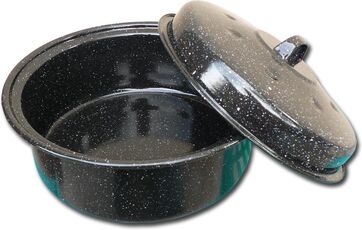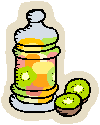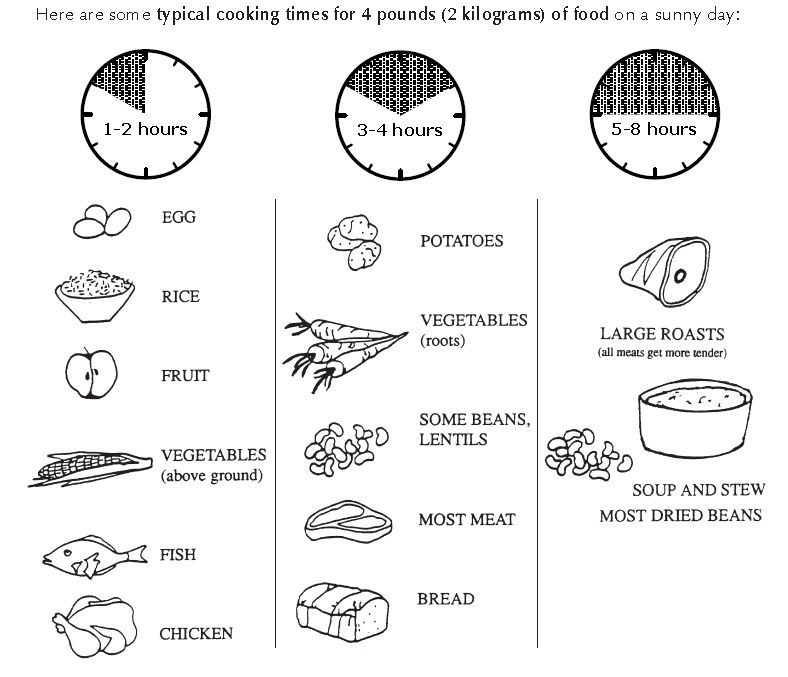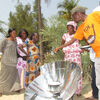- 0 Talk
-
Introduction & Cooking Tips
| | Previous: Recipes |
| Next: Beverages | |
| Recipes |
|
Introduction & Tips |
[Note: The recipes on this Wiki have been developed for the simple solar box cookers with one reflector which cook at temperatures between 120°C and 150°C (250°F - 300°F). Recipes may need to be adapted when cooking with solar panel cookers and parabolic cookers.]
Contents |
Guidelines by food type Edit
Edit
COOKED DRIED CEREALS AND GRAINS - (barley, corn, millet, oats, quinoa, rice, wheat) : 2 hours. Start with usual amount of water. Next time adjust to your taste. If your sky conditions are less than ideal, you may have better luck if you preheat the water and grain separately, as suggested for pasta. This is especially helpful if the grain is either very slow to tenderize (brown rice, hulled but not pearled barley) or gets mushy easily (quinoa, millet). To learn about using barely-sprouted grains and beans, which take to sun cooking very well, see Sprouting seeds and grains.
See also Rice and Hard porridge.
VEGETABLES - Add no water. Artichokes: 2 1/2 hours; Asparagus: 1 1/2 - 2 hours; Other fresh green vegetables: 1-1 1/2 hours. If cooked longer they will taste fine but lose their nice green color. Beans - dried: 3-5 hours. Usual amount of water, can be soaked ahead of time; Beets, Carrots, Potatoes and other root vegetables: 3 hours. Cabbage, eggplant: 1 1/2 hours if cut up. Eggplant turns brownish, like a cut apple, but the flavor is good; Corn on the cob: 1 - 1 1/2 hours. The corn kernels will fade slightly if left longer in direct sunlight. The husk will hold the moisture in and protect the kernels naturally. A clean black sock can be put over an ear of corn to help absorb heat for faster cooking time. Squash, zucchini: 1 hour. Will turn mushy if left longer.
EGGS - Add no water. Two hours for hard yolks. If cooked longer the whites turn brownish, but the flavor is the same.
MEATS - Add no water. If cooked longer they just get more tender. Fish: 1-2 hours; Chicken: 2 hours cut up, 3 hours whole; Beef, Lamb, etc.: 2 hours cut up, 3 - 5 hours for large pieces; Turkey, large, whole: all day
PASTA - Heat water in one pot and put dry pasta with a small amount of cooking oil in another pot, and heat until water is near boiling. Add hot pasta to hot water, stir, and cook about 10 minutes more.
BAKING - is best done in the middle of the day (9 or 10 am - 2 or 3 pm) Breads: Whole loaves - 3 hours; Cakes: 1 1/2 hours; Cookies: 1 - 1 1/2 hours and do not need to be covered. Avoid bottom crusts - they get soggy. Black socks can also be used to cover foil-wrapped garlic/herb breads. Takes awhile for the heat to work through, but with the sock to dull the foil it eventually will, and the sun makes wonderful fresh garlic bread.
SAUCES & GRAVIES MADE WITH FLOUR OR STARCH - Heat juices and flour separately, with or without a little cooking oil in the flour. Then combine and stir. It will be ready quickly.
ROASTING NUTS - Bake uncovered. Almonds: 1 hour, Peanuts: 2 hours.
TYPICAL COOKING TIMES FROM Solar Cookers: How to make, use, and enjoy, Solar Cookers International, 2004
General guidelines Edit
Edit
- After a a bit of experience, you’ll see how readily you can adapt your present cooking and baking to solar cooking. Using the solar cooker can actually reduce the total amount of effort in meal preparation. Also cooking outside in the summer allows you to eliminate extra heat in the house. With solar cooking, you start your meals early in the day and then relax. At lunch or later in the afternoon or evening, when you’re tired after a day of work, the sun will have cooked your food.
- Most food, with the exception of cookies and open-faced cheese sandwiches, are cooked in containers with the lids on. The dark, speckled GranitWare pots are the best for most of the cooking and baking in the solar cooker. (The 9-inch round roaster makes a beautiful round loaf of bread). Be sure to use hot pads when removing the pots from the oven; the pot will be very hot!
- If this is your first attempt at solar cooking, start with something easy such as chicken, rice, zucchini, or quick bread such as banana bread. Baking potatoes is also easy, but don't wrap them in aluminum foil; just put them in a dark covered pot without adding any water.

 Added by Tom Sponheim
Added by Tom Sponheim- Food such as roasts, stews, casseroles, poultry, potatoes, carrots, pot roasts and rice are almost impossible to overcook; therefore, the timing on the food is not critical.
- Chicken will still be juicy and will fall of the bone when solar cooked four hours instead of the needed two hours. The major advantage of solar cooking is the flexibility in cooking times. You can remove the food any time after it is done.
- In cooking fresh fish, you can judge when the fish is cooked thoroughly when juice begins to drop. If you cook fish on a rack, it is easy to see this change. Then check to see that the fish is cooked to the bone in the thickest part.
- For best results, do not overcook the following food: green vegetables, cookies, cakes, and bread.
- Use dark covered pots or pans with tight fitting lids. With rare exceptions (e.g., cookies) the lid is kept on the pot while cooking. Dark baking pans can be purchased in pairs so one can be turned upside-down for a lid. Secure with binder clips.
- The golden rule of solar cooking is: GET THE FOOD ON EARLY, AND DON’T WORRY ABOUT OVERCOOKING.
- You do not need to stir food while cooking. However, it’s OK to check the food if you quickly replace the lid.
- Place the hard-to-cook or larger quantity items in the back of the cooker where they will receive more direct sun. When using several pots, place the easy-to-cook food in the front of the cooker.
- The solar oven will be hot! Use potholders when removing lids or pots.
- To keep the food hot after the sun goes down, add several bricks or heavy stones when you begin cooking. To maximize heat retention, lower the reflective lid onto the glass, and cover the cooker with a blanket.
- Many meals may be cooked without refocusing, and you will learn by experience. Just face the cooker so that halfway through the cooking time the sun will be right in front of the cooker with the prop stick casting a shadow on the proper stick holder. With lots of food, or on less than fully sunny days, refocus the oven once or twice.
- To bake cakes or bread in a solar box cooker, preheat the cooker for at least ½ hour before adding the food.
- If you are cooking a large amount of food, it will cook more quickly if distributed between two or three smaller pots instead of one large pot.
- Several small, uncovered bowls may be placed inside a large covered pot to cook.
- Leftovers are easily reheated in the solar cooker.
- Most recipes take slightly less liquid when cooked in a solar oven.
- Time for cooking depends on the temperature of the food as it is placed in the oven, as well as the brightness of the day.
- Allow plenty of time. Foods hold well in the solar oven without scorching or drying out.
- Focus oven and check food about once an hour when you're just getting started. Later, you'll relax and tend the cooking only once every two or three hours.
- Most recipes calling for a higher temperature will do fine if you give them more time.
High altitude adjustment Edit
Edit
The temperature of boiling water is reduced as the altitude increases. For instance the boiling temperature of water is only 95°C (203°F) at 6000 ft. and this slows the cooking. Vegetables and dried beans may be difficult to cook at high altitudes because of this effect. You may try cooking your food in darkened canning jars with regular canning lids and rings tightened. The rubber seal allows excess pressure to be released but a low increase in pressure is retained and speeds cooking. We only recommend standard canning jars and lids as they are designed for pressure.
See also:  Edit
Edit
| | Previous: Recipes |
| Next: Beverages | |














